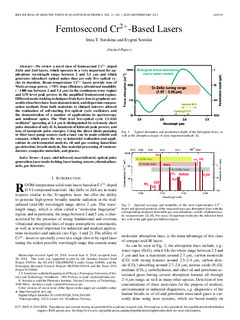| dc.contributor.author | Sorokina, Irina T | |
| dc.contributor.author | Sorokin, Evgeni | |
| dc.date.accessioned | 2017-11-07T09:51:10Z | |
| dc.date.available | 2017-11-07T09:51:10Z | |
| dc.date.created | 2016-01-18T14:10:53Z | |
| dc.date.issued | 2015 | |
| dc.identifier.citation | IEEE Journal of Selected Topics in Quantum Electronics. 2015, 21 (1), . | nb_NO |
| dc.identifier.issn | 1077-260X | |
| dc.identifier.uri | http://hdl.handle.net/11250/2464526 | |
| dc.description.abstract | We review a novel class of femtosecond Cr2+-doped ZnSe and ZnS lasers, which operates in a very important for applications wavelength range between 2 and 3.5 μm and which generates ultrashort optical pulses that are only five optical cycles in duration. Room-temperature Cr2+-lasers provide tens of Watts average power, >70% slope efficiency, ultrabroad tunability (~1400 nm between 2 and 3.4 μm) in the continuous wave regime and GW-level peak powers in the amplified femtosecond regime. Different mode-locking techniques from Kerr-lens to graphene saturable absorbers have been demonstrated, and dispersion compensation methods from bulk materials to chirped mirrors allowed the realization of self-starting few-optical cycle oscillators and the demonstration of a number of applications in spectroscopy and nonlinear optics. The Watt level few-optical cycle Cr:ZnS oscillator1 operating at 2.4 μm is distinguished by extremely short pulse duration of only 41 fs, hundreds of kilowatt peak powers, and tens of nanojoule pulse energies. Using the direct diode-pumping or fiber laser pump sources such a laser can be made reliable and compact, which paves the way to industrial realisation and applications in environmental analysis, oil and gas sensing, hazardous gas detection, breath analysis, fine material processing of semiconductors, composite materials, and glasses. | nb_NO |
| dc.language.iso | eng | nb_NO |
| dc.publisher | Institute of Electrical and Electronics Engineers (IEEE) | nb_NO |
| dc.relation.uri | http://ieeexplore.ieee.org/xpls/icp.jsp?arnumber=6861943 | |
| dc.title | Femtosecond Cr2+-based lasers | nb_NO |
| dc.type | Journal article | nb_NO |
| dc.type | Peer reviewed | nb_NO |
| dc.description.version | publishedVersion | nb_NO |
| dc.source.pagenumber | 19 | nb_NO |
| dc.source.volume | 21 | nb_NO |
| dc.source.journal | IEEE Journal of Selected Topics in Quantum Electronics | nb_NO |
| dc.source.issue | 1 | nb_NO |
| dc.identifier.doi | 10.1109/JSTQE.2014.2341589 | |
| dc.identifier.cristin | 1316021 | |
| dc.relation.project | Norges forskningsråd: 219686 | nb_NO |
| dc.relation.project | Norges forskningsråd: 191614 | nb_NO |
| dc.description.localcode | © 2014 IEEE. Translations and content mining are permitted for academic research only. Personal use is also permitted, but republication/redistribution requires IEEE permission. | nb_NO |
| cristin.unitcode | 194,66,20,0 | |
| cristin.unitname | Institutt for fysikk | |
| cristin.ispublished | true | |
| cristin.fulltext | postprint | |
| cristin.qualitycode | 2 | |
